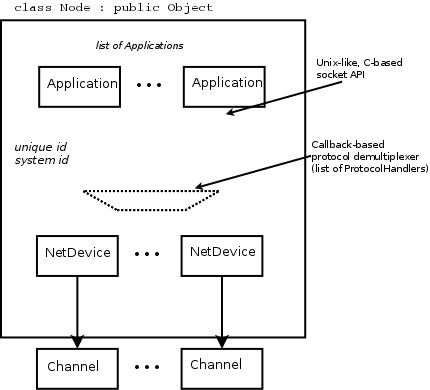
|
A Discrete-Event Network Simulator
|
Models |
This chapter describes how ns-3 nodes are put together, and provides a walk-through of how packets traverse an internet-based Node.

High-level node architecture
In ns-3, nodes are instances of ns3::Node. This class may be subclassed, but instead, the conceptual model is that we aggregate or insert objects to it rather than define subclasses.
One might think of a bare ns-3 node as a shell of a computer, to which one may add NetDevices (cards) and other innards including the protocols and applications. High-level node architecture illustrates that ns3::Node objects contain a list of ns3::Application instances (initially, the list is empty), a list of ns3::NetDevice instances (initially, the list is empty), a list of ns3::Node::ProtocolHandler instances, a unique integer ID, and a system ID (for distributed simulation).
The design tries to avoid putting too many dependencies on the class ns3::Node, ns3::Application, or ns3::NetDevice for the following:
From a software perspective, the lower interface of applications corresponds to the C-based sockets API. The upper interface of ns3::NetDevice objects corresponds to the device independent sublayer of the Linux stack. Everything in between can be aggregated and plumbed together as needed.
Let’s look more closely at the protocol demultiplexer. We want incoming frames at layer-2 to be delivered to the right layer-3 protocol such as IPv4. The function of this demultiplexer is to register callbacks for receiving packets. The callbacks are indexed based on the EtherType in the layer-2 frame.
Many different types of higher-layer protocols may be connected to the NetDevice, such as IPv4, IPv6, ARP, MPLS, IEEE 802.1x, and packet sockets. Therefore, the use of a callback-based demultiplexer avoids the need to use a common base class for all of these protocols, which is problematic because of the different types of objects (including packet sockets) expected to be registered there.